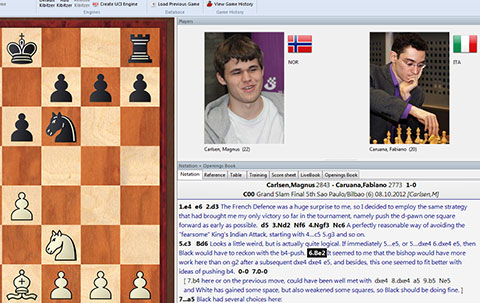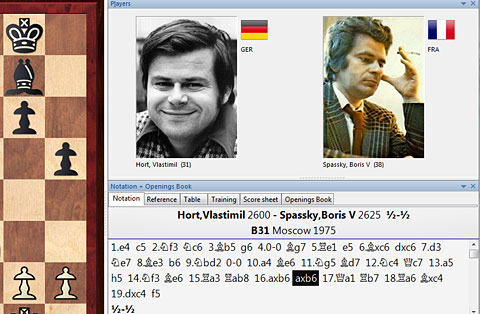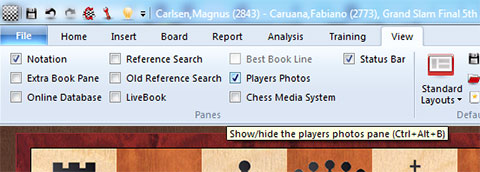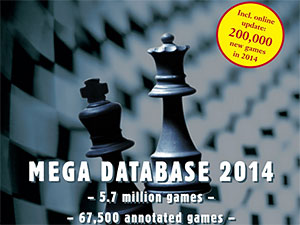When describing Mega Database 2014, it is easy to get caught up in all the numbers, however impressive they may be, but this truly is the Rolls-Royce of chess databases with none even a close second. The reason is not in the numbers but in every aspect that make it such a wonderful tribute to chess, and indispensable tool.

Of course, the numbers do say a lot, so let's get them out of the way:
- Nearly 5.8 million games
- Close to 68 thousand commented games
- Over 293 thousand player entries
- 33 thousand pictures
5.8 million games
The database is difficult to quantify since the games list includes opening surveys, game excerpts, and even short games or game entries with no moves. This last element bears explaining since one might think this is a way to cheat and pad the numbers artificially. There are tournaments, whether very old, or not so old, where only the result is known for a game or others. Why are these then added? Quite simply to be able to create a complete crosstable.

This crosstable is only possible because of the 'blank' gamescores of a few games, for which
the result is known, but not the moves. Otherwise it would be full of missing results. A blank
game score also will not appear in the statistics of an opening, so it has no detrimental value.
Sometimes even this is not enough to complete a tournament crosstable, but little by little, new finds are contantly brought in, and in the end, they do add up. In fact, it would be a mistake to think the grand total of Mega 2014 is only Mega 2013 plus all the games played in the last year. Although it contains all the games from previous additions with the added games of 2013, the work at improving the core database is a non-stop process, and includes improved headers, names, as well as rare games uncovered during the year included by experts as well as sent from a variety of contributors.
A cursory example can be seen with classic masters. Mega 2011 had 2201 games with Alexander Alekhine, while Mega 2012 had 2207 games, and now there are 2214. Boris Spassky had 2472 games in Mega 2011, whereas in Mega 2012 there were 2492, and now in Mega 2014 there are 2515, and no these aren't games played in the last year. The last entry for Spassky, for example, is from 2009.
68 thousand commented games
Then there is that mindboggling other number, that promises more than statistics: nearly 68 thousand commented games. One can lose sight of what that really contains. Instead, it bears looking at it a bit differently: looking for a book of games commented in depth by Magnus Carlsen himself? There is only one: Mega Database. In it are no fewer than 24 games he has commented in soul-searching depth. How about world number two Levon Aronian? 21 games commented by the great Armenian. Vladimir Kramnik has analyzed 63 games, Garry Kasparov did 57, and the list goes on and on.

Where else will you find dozens of commented games by Magnus Carlsen himself?
The depth of the commented games is not limited to the last couple of decades either. For anyone willing to do a bit of digging, there is gold to be found. Consider this little nugget:

This sort of buried treasure is typical: a correspondence game between Chigorin and
Steinitz from 1890, in which one finds detailed comments by Steinitz himself, Chigorin,
Myers, and... even Garry Kasparov!
Just to show you, here is the game with the comments. One small warning: there were numerous openings references to further games with this Evans Gambit line, which I removed for conciseness.

[Event "Cable m 9091"] [Site "USA"] [Date "1890.10.13"] [Round "1"] [White "Chigorin, Mikhail"] [Black "Steinitz, William"] [Result "1-0"] [ECO "C52"] [Annotator "Steinitz"] [PlyCount "75"] [EventDate "1890.10.13"] [EventType "match"] [EventRounds "2"] [EventCountry "USA"] [Source "ChessBase"] [SourceDate "2012.11.22"] {Myers: This is game #1 of a 2-game correspondence match played for a stake of $750. The openings were pre-arranged by the players. Chigorin's play was deeper and sounder, and Steinitz was rightfully defeated in convincing fashion. It is evident from the games that Chigorin invested the greater effort.} 1. e4 {Myers Lipnitsky Avery Kasparov Edwards Russell Steinitz} e5 2. Nf3 Nc6 3. Bc4 Bc5 4. b4 Bxb4 5. c3 Ba5 6. O-O Qf6 7. d4 Nh6 $6 $146 {Steinitz: The move here adopted has never before been tried in actual play, but was a new suggestion which I made in my "Modern Chess Instructor".} 8. Bg5 Qd6 9. d5 $1 Nd8 $5 10. Qa4 (10. Qd3 $5) 10... Bb6 {Lipnitsky: Given that the two players held opposing views on this line of the Evans Gambit, the game is a special kind of creative duel. Black has an extra pawn. It is hard for White to open up lines for an attack on the black king, which is fairly securely placed. It is easy to see that White has no sharp attack in the gambit style. But something else is obvious: White has a lasting initiative on every part of the board. Chigorin demonstrates that this more than compensates for the sacrificed pawn.} 11. Na3 c6 $2 (11... Qg6 $142 $1 $132 {Steinitz}) (11... O-O $142 $5 {Myers} 12. Bd3 Qg6 13. Nc4 {Kasparov} f6 14. Nxb6 cxb6 15. Bxh6 Qxh6 16. d6 $14 {Myers}) 12. Be2 {Steinitz: In general, I may remark that my antagonist's attack is of the same description as in most of the games which we have played together, and it is representative of the old school. He believes in advancing the pawns, and sacrificing one or more of them in order to create difficulties on the K-side, or for the purpose of blocking his opponent's pieces; whereas I maintain that the King is a strong piece that can usually take care of itself, and that in his style of attack Chigorin has to employ powerful pieces in order to block inferior ones. In the end, I opine that as usual, my minor pieces will thoroughly develop, while his far advanced pawns, which cannot retrace their steps, will form weak marks for my own ultimate counter-attack.} Bc7 $6 (12... Ng4 $5 13. Nc4 Bxf2+ 14. Rxf2 Qc5 15. Bh4 b5 16. Qa3 Qxa3 17. Nxa3 Nxf2 18. Bxf2 f6 19. Rd1 a5 20. Nh4 Nf7 21. Nf5 g6 22. Ng3 h5 $132 {Myers}) 13. Nc4 Qf8 (13... Qg6 14. Bxd8 Kxd8 (14... Bxd8 15. Nfxe5 Qf6 16. Qa3 Be7 17. d6 $16 {Kasparov}) 15. Ncxe5 Qf6 16. Nd3 cxd5 17. e5 Qc6 18. Qh4+ $18 {Myers}) 14. d6 $1 {Myers: Steinitz is still not willing to admit that he is in trouble. He wrote, "In a match over the board, I would undertake to play the identical variation up to this point against any living player, at least four times, and if either Chigorin or Gunsberg were to offer me a draw at that stage, I would refuse."} (14. Qd1 $5 cxd5 15. exd5 Nf5 16. Nfxe5 Qc5 17. Bg4 d6 18. Ne3 dxe5 19. Nxf5 Bxf5 20. Bxf5 O-O 21. Qg4 $18 {Myers }) 14... Bxd6 $8 15. Nb6 (15. Bxd8 $5 Kxd8 $8 16. Nb6 Rb8 17. Qxa7 Bc7 18. Rfd1 $1 (18. Rab1 Ke7 $5 $132 {Steinitz}) 18... Ke7 (18... Ng4 $2 19. Rab1 Qc5 20. Nxc8 Qxf2+ 21. Qxf2 Nxf2 22. Kxf2 $18) 19. Rd2 d6 20. Na8 Rxa8 (20... Qd8 21. Nxe5 $18) 21. Qxa8 f5 22. exf5 Qxf5 23. Bd3 e4 24. Bxe4 Qa5 25. Qxa5 Bxa5 26. Re2 $18 {Myers}) 15... Rb8 16. Qxa7 Ne6 (16... Ng4 $2 17. Nh4 Ne6 18. Bxg4 Nxg5 19. Nf5 Ne6 20. Rfd1 Bc7 21. Na8 Rxa8 22. Qxa8 Kd8 23. Rxd7+ Kxd7 24. Rd1+ { 1-0 Gunsberg,I-Steinitz,W/New York USA 1891/}) (16... Ng8 $2 17. Bxd8 Kxd8 18. Bc4 Bc7 19. Rfd1 Qe7 20. Na8 d6 21. Nxc7 Kxc7 22. Rab1 f5 23. exf5 Bxf5 24. Rb6 $18 {Myers}) 17. Bc1 $1 {Myers: Steinitz could be generous with his praise: "This move, like White's 12th and 14th moves, bears the stamp of genius."} Ng8 {Steinitz: I consider that now, that is, after Black's 17th move, my position is better than it was at the start of the game, and I am ready to lay odds of two to one that my opponent will not win. In other words, I undertake to draw at least.} (17... Qe7 18. Ba3 Nf4 $2 (18... c5 $5) 19. Bc4 $1 (19. Rfe1 { Steinitz} Qe6 20. Ng5 $18) 19... Qf6 20. Rfd1 Bc7 21. Na8 $18 {Myers}) 18. Ba3 $1 c5 {Myers: Black's position is totally busted, but Steinitz in his commentary, which was published as the game progressed, speaks as if the position is difficult for Black but unclear, with a hard-fought draw as a distinct possibility.} 19. Rad1 $1 (19. Rfd1 $5 Nf6 {Steinitz} 20. Ng5 $1 Nxg5 21. Nc4 Bc7 22. Bxc5 Qg8 (22... d6 23. Nxd6+ Bxd6 24. Bxd6 Qxd6 25. Rxd6 $18) 23. Bd6 Nfxe4 24. Bxc7 Nxc3 25. Qxb8 Nxe2+ 26. Kf1 Ke7 27. Bd6+ Ke6 28. Bxe5 $18 {Myers}) 19... Nf6 (19... Bc7 20. Bb5 $1 Nf6 21. Nd5 Bd6 22. Nh4 (22. Nxf6+ gxf6 23. Nh4 $18 {Steinitz}) 22... Nxd5 23. Rxd5 Bc7 24. Nf5 g6 25. Rfd1 gxf5 26. Rxd7 Bxd7 27. Rxd7 Qh6 28. Bxc5 Nxc5 29. Qxc5 $18 {Chigorin}) 20. Bc4 (20. Ng5 $5) (20. Bb5 Qe7 21. Nd5 Nxd5 22. exd5 Ng5 {Myers: Steinitz here expresses optimism for Black's positon, although White has a concrete winning variation at his disposal.} 23. Nxg5 $3 Qxg5 24. f4 $3 Qh5 25. Qb6 $1 Qh6 26. Bxc5 Bxc5+ 27. Qxc5 b6 28. Qc7 Ra8 29. Qxe5+ Kd8 30. d6 Re8 31. Qd5 $18 {Myers} ) 20... Bc7 (20... Nxe4 21. Nxc8 Rxc8 22. Qxb7 Rc6 23. Nxe5 $18 {Kasparov}) ( 20... Qe7 21. Bxe6 fxe6 22. Nc4 Bc7 23. Bxc5 $18 {Kasparov}) 21. Nd5 (21. Rfe1 $142 $1 Nd8 22. Na8 Bd6 23. Qxc5 $1 Ne6 (23... Bxc5 24. Nc7+ Ke7 25. Bxc5+ d6 26. Bxd6+ Kd7 27. Nxe5#) 24. Qa7 Bxa3 25. Qxb8 Qc5 26. Bxe6 fxe6 27. Qxe5 d6 28. Qxc5 Bxc5 29. e5 $1 $18 {Myers}) (21. Nxc8 $142 $1 Rxc8 22. Qxb7 Kd8 23. Bxe6 fxe6 24. Ng5 $18 {Edwards}) 21... Bd6 22. Nh4 Nxd5 (22... b5 23. Nf5 Rb7 24. Nxf6+ gxf6 25. Qa6 Bb8 26. Bxb5 $18 {Myers}) 23. Nf5 g6 24. Nxd6+ $1 Qxd6 25. Bxd5 (25. exd5 $1 Nf4 (25... Ng5 26. Bxc5 Ra8 27. Bxd6 Rxa7 28. Bxe5 O-O 29. Bd4 $18 {Myers}) 26. Bxc5 Qc7 27. Rfe1 d6 28. Bb5+ Ke7 29. Rxe5+ $18 { Edwards}) 25... Qc7 26. Bxe6 fxe6 27. Bxc5 Ra8 28. Qxa8 Qxc5 29. Qa4 (29. Qb8 $1 Rf8 30. Qd6 b6 31. a4 Rf4 32. Rd5 $1 $18 {Myers}) 29... Kd8 30. Rd2 Kc7 { Myers: This move does not lessen Steinitz's difficulties, but he does not comment. For Black, the picture is increasingly hopeless.} 31. Rb1 $1 Rd8 ( 31... d6 32. Rb4 $1 {Kasparov} Kb8 33. c4 h5 34. Rb5 Qc6 35. Qb4 Rd8 36. Rxe5 $18 {Myers}) 32. Rb5 $1 Qc6 33. Qb4 d6 34. a4 $1 Qe8 (34... Bd7 35. Rxd6 $1 { Kasparov} Qxd6 36. Rxb7+ Kc8 37. Qxd6 $18) 35. Rb6 Qf8 36. Qa5 $1 d5 (36... Kb8 37. Rdb2 $1 Rd7 38. Ra6 b6 39. Ra8+ Kb7 40. Qxb6+ Kxa8 41. Qb8# {Myers}) 37. exd5 Kb8 38. d6 {Steinitz resigned in April of 1891, with a full range of excuses offered up to his readers of the "International Chess Magazine". "The telegraph battle," wrote Kasparov, "provoked an unprecedented surge in the popularity of chess in many countries." And Lasker recalled many years later: "The games of the telegraph match made a startling impression on me. To crush Steinitz in such a way--this seemed incredible!"} 1-0
33 thousand pictures
Again, this is not simply a large number of pictures sent by players, but also contains multiple pictures of the same players. Take Boris Spassky for example, a player with a long career, and Vlastimil Hort.

Pulling up a game from 1962 between the two from the world U26 championship
shows a very young Hort, aged 18 (note the ages in parentheses) and Spassky
who is 25. Suppose we roll the clock forward to... 1975.

Now we see an adult Hort, 31 years old (again, note the age in parentheses)
facing a 38-year-old Boris Spassky. The pictures have changed to reflect this.

Finally we leap forward in time to 1999 where we have a graying Hort, 55, and
Spassky, silver haired and 62
Certainly the pictures cannot be considered essential to studying, but putting a face to the player is certainly pleasant, and reminds us there was a person behind those moves, struggling and competing. In fact, even when there are no photos to go by, such as the great Philidor, images depicting him are used instead.

If you own Mega 2014, or a previous edition, and do not see the player photos,
open a game from Mega and in the View tab put a check in Players Photos
A year of updates
There is no question that Mega Database is not the cheapest item in the ChessBase catalogue, even if it is one of the most desirable, nevertheless the pricetag also includes a full year of weekly updates to ensure the database is always up-to-date. At an average of 5000 games per week, these games are also cleaned up so the headings all follow the same spelling that has been painstakingly normalized over the years. Anyone who recalls the databases years back with half a dozen Korchnois, all with different spellings, to cite but one example, can appreciate the importance of this.
If you had the choice between buying five games collections or one Mega Database, believe me the choice is a no-brainer. This database is more than just a collection of games trying to wow you with big numbers. The depth and quality attest to professionalism and a love of chess.
Available in the ChessBase Shop











